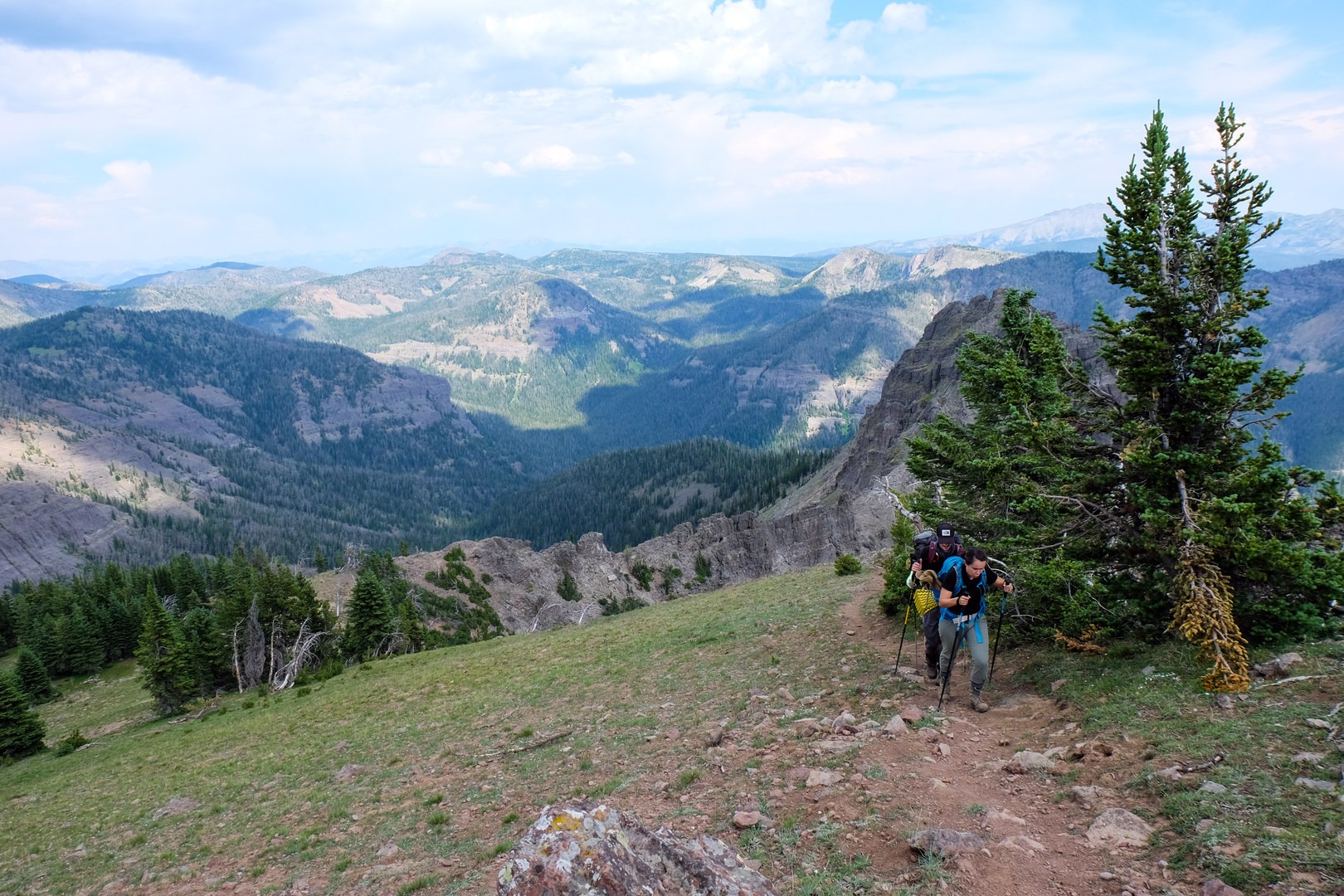You are here
The Sky Rim Trail may just be the best alpine hike in Yellowstone National Park. The trail runs the length of a mountain ridgeline with incredible panoramic views of mountains rolling almost endlessly to the horizon. You are submerged in the heart of the Gallatin Range, a landscape rich with wildlife in Montana’s less-visited corner of Yellowstone.
The hike begins from the Specimen Creek Trailhead. Parking here is ample, for both foot and stock parties. The single track dirt path takes you into a lodgepole forest and winds along the northern bank of Specimen Creek. As you near the 2-mile mark, the forest gives way to an open meadow with a clear view of Meldrum Mountain. See the remnants of a 2007 fire, especially noticeable toward the Sportsmans Lake Trail. The trail turns and runs along the North Fork of Specimen Creek in the shadow of two mountain slopes.
The climb to Shelf Lake is relentless — take a break or two to enjoy the wildflower show in the small patches of open mountainside. Admire the blue green waters of Shelf Lake and the surrounding alpine scenery, which includes Sheep Mountain to the north.
At last, make the final 0.2-mile push to reach the Sky Rim Trail. This trail marks the border between Yellowstone and the Gallatin National Forest, so look for the weathered boundary signs. Walk briefly through a stand of trees to see the ridgeline open up before you. You’ll be in for some ups and downs, but the views make up for it. The best views are at Big Horn Peak, the trail’s highest point. To the north, see Ramshorn Peak, Twin Peaks, Steamboat Mountain and Packsaddle Peak. See peaks such Lone Mountain (of the famous Big Sky Resort) and Sphinx Mountain in the Madison Range to the west. Electric Peak is unmistakable to your southeast. The Absaroka Range is visible to the east if you’re lucky enough to pick a day without looming wildfire haze.
From Big Horn Peak, the trail crosses a very narrow section of ridge. Drop-offs are perilous here, so tread carefully. The trail is lost on the big open grassy mountainside. To connect to Black Butte, swing a left down the green slope and look for the bright orange blazes. From here, the trail descends on an impressive amount of switchbacks alternating through forest and open sagebrush. The landscape levels out for the last 2 miles to the Black Butte Trailhead. If you are watchful (and lucky), you might get a glimpse of one of Yellowstone’s rare moose.
There are five backcountry sites over the full stretch. WE1 and WE4 are along Specimen Creek. WE5 and WE7 are on the banks of Shelf Lake and are the best backcountry camps on the route. Find the last campsite, WF1, after your long descent from Big Horn Peak. Shelf Lake sites are the first to get snagged and are hard to come by for weekend trips or walk-up availability.
The Sky Rim Trail runs 9 miles from the Dailey Creek Trail Junction to Sheep Mountain (this hike covers three of those miles). The trail is not for novice hikers; the long distance and tough climbs (especially with a pack) will put your aerobic system to work. Afternoon storms, which are common during the summer, are an added risk as well. Hiking along this barren ridge makes you a prime lightning target. If you'll be hiking in July, you would do well to pack a quick tarp shelter. Your storm risk is lower in August, but be prepared for hot temperatures on a trail with no water source. Stock up on water from either Dailey Creek, Black Butte Creek or Shelf Lake.
Logistics + Planning
Current Weather: Powered by Dark Sky
























Comments
The “Sky Rim trail” refers to the 9 miles on the park’s boundary between the WN1 (Dailey Creek & Sky Rim junction) and Sheep Mountain. How much of those 9 Sky Rim miles you do depends on where you start and finish. Sheep Mountain is just northeast of Shelf Lake. From Sheep Mountain, if you kept going southwest (and didn’t take the short downhill trail to Shelf Lake) toward Big Horn Peak, you’re on the Sky Rim. From Big Horn Peak, the Sky Rim extends northwest to WN1.
Hope this helps!
Sign In and share them.